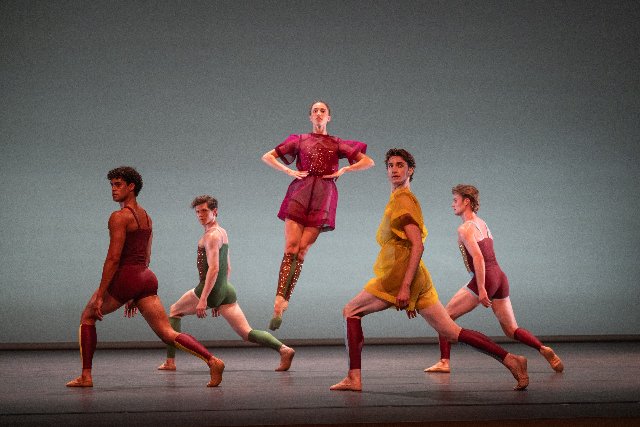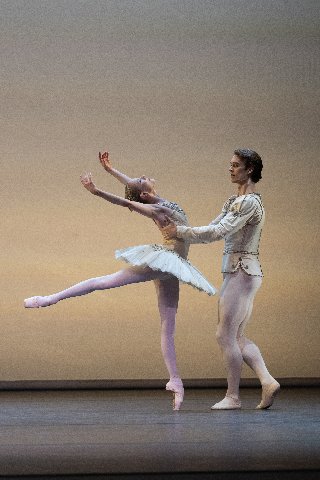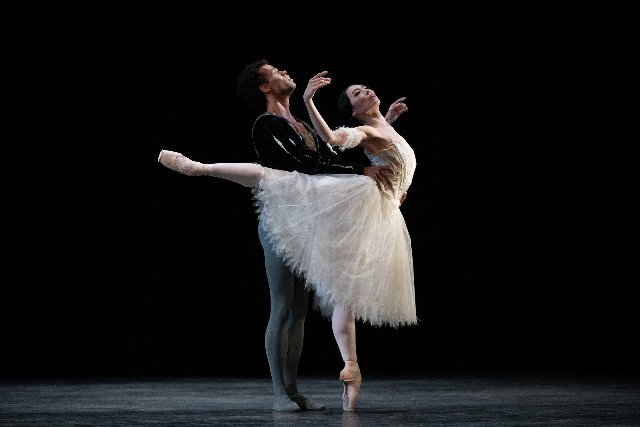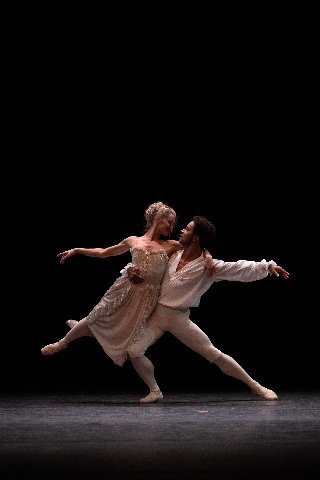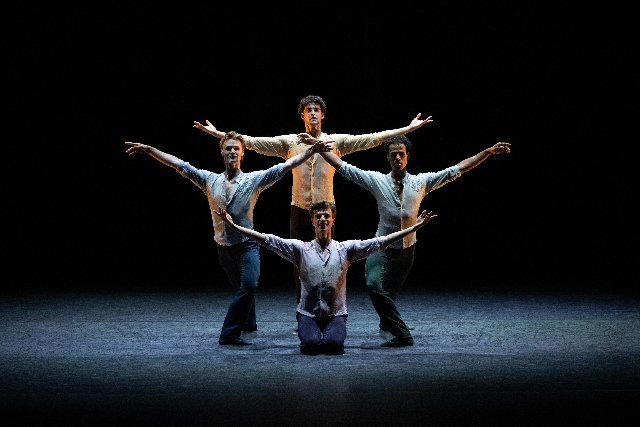Royal Ballet at Jacob's Pillow
First Visit to the Berkshires
By: Charles Giuliano - Jul 08, 2024
The Royal Ballet
Ted Shawn Stage and McCain Stage
Jacob’s Pillow July 3 to 7, 2024
Patron, The King
President, The Lady Sarah Chatto
Director, Kevin O’Hare
Music director, Koen Kessels
Resident choreographer, Sir Wayne McGregor
Artistic associate, Christopher Wheeldon
Administrative director, Heather Baxter
Rehearsal director, Christopher Saunders
Secret Things (2023) Excerpt
Choreography, Pam Tanowitz
Music, Anna Clyne
Diamonds, pas de deux from Jewels
Choreography, George Balanchine
Music, Pyotr Illyich Tchaikovsky
Dancers, Sarah Lamb and Lukas B. Braendsrod
Giselle, Act II, pas de deux
Choreography, Marius Petipa after Jean Coralli and Jules Perrot
Music, Adolph Adam
Dancers. Mariko Sasaki and Joseph Sissens
Diana and Actaeon, pas de deux
Choreography, Agrippina Vaganova after Marius Petipa
Music, Riccardo Drigo
Dancers, Meaghan Grace Hinkis, Francisco Serrano
Four Brahms Waltzes in the Manner of Isadora Duncan (1976)
Choreographey, Frederick Ashton
Music, Johannes Brahms
Dancer, Nadia Mullova-Barley
For Four (2006)
Choreography, Christopher Wheeldon
Music, Franz Schubert
Manon (1974) Act 1, pas de deux
Choreography, Kenneth MacMillan
Music, Jules Massenet
Dancers, Anna Rose O’Sullivan, Marcelino Sambe
Carousel (1992) If I Loved You, pas de deux
Music, Richard Rodgers
Arrangement, Martin Yates
Dancers, Mayara Magri, Matthew Ball
Figures in a Landscape (2024) World Premiere
Choreography, Wayne McGregor
Music, Nicholas Becker, John Cage, Ben Frost, Abraham Marder
Costumes, Issey Miyake
Lighting, Chris Wilkinson
Both the Royal Ballet and Jacob’s Pillow were formed in 1931. There have been many interactions but in the current season the renowned company has visited the Berkshires for the first time. It is their only North American stop.
Some five years of planning, fund raising, and logistics were entailed for this historic event. There was an intensive dialogue about programming. The company is renowned for flawless presentations of classical ballet. But is also deeply committed to creating new work. Given Pillow’s reputation for the cutting edge the initial plan was to present a program reflective of that mandate.
Artistic director, Pamela Tatge, argued that the audience deserved to see the classics as well. What resulted is the full range of Royal Ballet in nine segments on the Ted Shawn stage. There was a parallel program of largely solos and pas de deux on the outdoor McCain Stage. Fortunately it proved to be a hot but dry week.
The coup of this rare visit by one of the world’s great companies resulted in a sold out run of twelve performances. The performance we attended was packed and the Ted Shawn Theatre was sweltering despite alleged AC. Fans were provided which fluttered furiously.
The real heat, however, was generated on stage as we attentively absorbed the subtly stylistic and mood shifts of the richly varied program. At every level, traditional or contemporary, this was an experience of utter perfection. In a sense, we were presented with the history of ballet and dance from the 1840s to the latest iteration. The performance ended with a riveting world premiere site-specifically created for Pillow.
The program was book-ended with challenging new work. Those experiences wrapped around the more comforting and familiar vignettes of classical ballet. There were a number of variations on the form of pas de deux. That allowed for experiencing variations within that mode. For those receptive to it, in nine parts, we were offered a lesson in the history of dance.
There was palpable energy and anticipation as a female dancer walked down the aisle approaching the stage. There she detoured and appeared on stage. It was Secret Things (2023) an excerpt, choreographed by Pam Tanowitz to music by Anna Clyne. I looked for clues from the unisex costumes by Reid Bartelme and Harriet Jung. All eight dancers wore glitter wrapped around their legs. The glitter element also entailed the front of male costumes. This had the result of making us think less of men and women and more of them as mobile elements in an ever morphing and complex dance. If there was a theme or narrative it was difficult to discern and a better approach was to accept it as reductive and abstracted. It evoked the trope that art does not have to be understood in order to be appreciated. This follows the notion of stop making sense, just enjoy, ars gratia gratis.
From feeling disoriented there was an easy and sublime transmission to, for me, the apogee of the entire experience. The pas de deux, Diamonds, from Jewels, highlighted the perfectionism of the company. There was the familiar prince Lukas B. Braendsrod paired with the exquisite Sarah Lamb. We would see her in several works.
Set to Tchaikovsky, the choreography of Balanchine is typically pure, technical and a bit chilling. It is rooted in the tradition that we associate with classical ballet. This pairing did not disappoint. Perhaps, like me, the audience was reassured by the familiar and traditional.
What followed was an excerpt from the romantic classic Giselle. Compared to the pure movement of Diamonds we have soupcon of the potboiler of ghosts and drama. It was performed with panache by Mariko Sasaki and the engaging mugging of the ever palpable Joseph Sissens. He was one of several principals who appeared in different dances. Overall, the men are a daunting strength of the company.
There was a very different energy and passion in Diana and Actaeon. We saw the goddess of the hunt performed by Meaghan Grace Hinkis. Her partner, Francisco Serrano, brought down the house with enormous leaps and fluttering foot work. This pas de deux seemed unfettered and exuberant compared to the others.
There was a wonderfully diverting sidebar into a recreation of Isadora Duncan (1877-1927) in four waltzes to Brahms. Duncan is one of the pioneers of modernism that we know more of than are actually familiar with the work. But the performance by Nadia Mullova-Barley was more than a history lesson. In her era she was a great rebel who broke away from ballet and founded modern dance. Here we see her barefooted and freeform. What a pure delight brought back to life by choreographer David Ashton.
Completing the cycle there would be two more examples of pas de deux. We catch a glimpse of Manon. The woman who lives by her wits (Anna Rose O’Sullivan) visits the impoverished writer, Marcelino Sambe. Seated at a desk she impishly tosses aside his quill pen. There is no future for their love but they are very much of the moment. They dance with conviction and abandon.
The final pas de deux If I Loved You from the Richard Rodgers musical Carousel could not have been more different. There is a wonderful arrangement of the music by Martin Yates. It is more useful to approach this engaging work as a duet than traditional pas de deux between Mayara Magri and Matthew Ball. She is the innocent millworker, Julie Jordan, resisting the advances of a carny worker the smarmy, sexy and disreputable Billie Baxter. It’s the timeless tale of a nice girl fending off the advances of a callous seducer. For just one night love prevails with terrible consequences. This was the most accessible and engaging segment of the program.
For Four (2006), by Christopher Wheeldon, highlights the great treasure of Royal Ballet its astonishing male dancers. In ballet terminology this is a pas de quatre. It’s most readily familiar from the unison quartet of Swan Lake. But here the men (Liam Boswell, Leo Dixon, Joseph Sissens and Francisco Serrano) form different configurations to music of Schubert. Each dancer is featured as a virtuoso soloist. Here the audience got its fill of leaps and bounds and then some. It speaks to the training, discipline and talent of Royal Ballet.
Nothing prepared us for the spectacular finale, a world premiere, Figures in a Landscape, by Wayne McGregor. There was a gasp when the back wall opened up to reveal nature bathed in light. At intervals the space was further augmented by dancers exiting and departing into this rustic habitat.
The music changed and at intervals was harsh and oppressive as was the relentless glare of in-your-face lighting. For a classical ballet company McGregor did not allows us to slip away with a warm and fuzzy feeling. Enjoyably there were elements of that but he insisted on locating us in the harsh reality of the here and now. The plan was to blow us away. If indeed that was the intent, Royal Ballet left us with much to think about regarding dance past, present and future.

